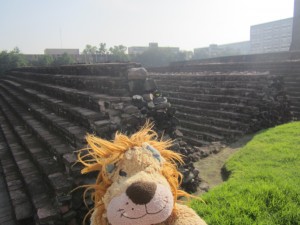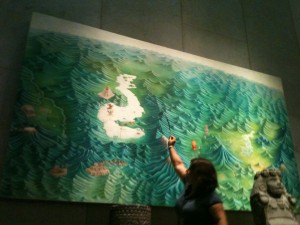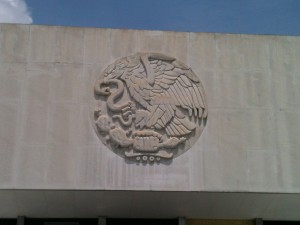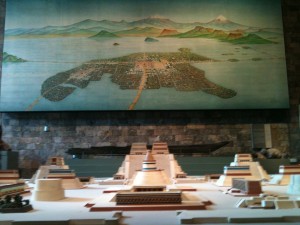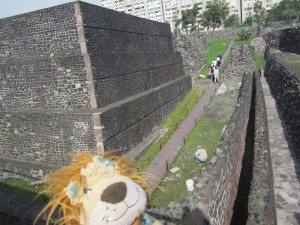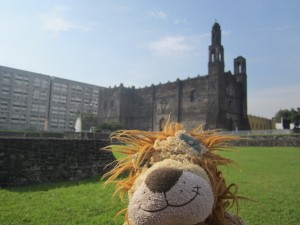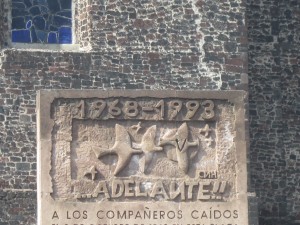Right behind the main cathedral, Lewis the Lion hit gold as he found what he was hoping to find in Mexico City: the excavation site of Aztec’s main temple, el Templo Mayor (the main temple) and its Sacred Precinct. Modern day Mexico City had in fact been built on the former Aztec capital, Technochitlan and Lewis the Lion thought that it was funny to think as he walked around that his little paws might just be wandering on top of it! He was delighted however to see that they had uncovered the main temple right in the heart of Mexico City because he liked to imagine how it might have been here 500 years ago when the Aztec Empire was at its height, before the Spanish Conquest.
What surprised him was that he learnt that Technochitlan had once stood in the middle of a huge lake. However, when the Spanish arrived and conquered the land, they decided that didn’t care for it too much and so drained it before they rebuilt Mexico City on the reclaimed land! ‘What a crazy thing to mess with nature like that!’ Lewis the Lion thought to himself and indeed he was right as even today Mexico City fights a constant battle against it sinking.
Looking at the archeological remains of the Templo Mayor and the Sacred Pricinct, Lewis the Lion realised both what a smart and what a barbaric people the Aztec were. On the one hand they had calculated with mathematical precision the movement of our planet and had a complete understanding of the calendar and the number of days in a year. However, on the other hand, the double staircases of the central temple shaped like a pyramid would often see streams of blood running down them as the Aztec performed human sacrifices to their gods, Huitzilopochtli, god of war and Tlaloc, god of rain and agriculture. This temple stood at the heart of the Aztec religious world. According to tradition it was here where their god Huitzilopochtli gave the Mexican people his sign that they had reached the promised land: an eagle on top of a nopal cactus with a snake in its mouth. You can see this symbol today on the Mexican flag.
Lewis the Lion discovered that this temple, the largest and most important building in the Sacred Precinct, was actually rebuilt six times from the year 1325 before the Spanish destroyed it in 1521.
Each new temple was built on top of the old one to represent the new phase of Aztec leadership. Lewis the Lion discovered that the four gates leading away from the temple are perfectly aligned with the cardinal points: north, south, east and west.
Surrounding the area was a serpent wall – ‘coatepantli’ – a sacred symbol to the Aztecs.
He particularly loved one of the buildings found close to the Templo Mayor, the Calendar Temple where there were symbols of a monkey, a skull, a dragon and a snake beside other things.
Beside this archeological site which had only started to be uncovered in recent years, Lewis the Lion saw the old cathedral which had been built by the Spanish using some of the bricks from the Aztec buildings.
It is badly suffering from subsidence due to the underground lake situation. He was reminded then by a plaque of the vicious war that was fought between the Spanish and the Aztecs that sustained heavy losses and brutalities on both sides.
“On 13th August 1521, heroically defended by Cuauhtemoc, Teleteloc fell to the power of Herandez Cortes.
It was neither a triumph nor a failure.
It was the painful birth of the mixed race which is today’s Mexico.”
In front of the old Cathedral was a huge square called “the place of the three cultures.”
When the Spanish first arrived they discovered one of the busiest market squares in the world. In this bustling market place all sorts of goods were being traded and the currency was cacao beans!
It is thanks to the Aztecs’ language, Nahuatl, that we have certain words in our language today like chocolate, avocado, chilli and tomato. These are definitely goods that would have been traded in this market place.
If you would like to know more about the Aztec culture, check out this website:
http://aztecs.mrdonn.org/index.html

